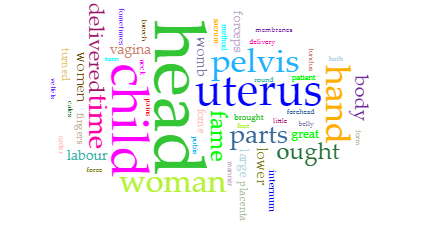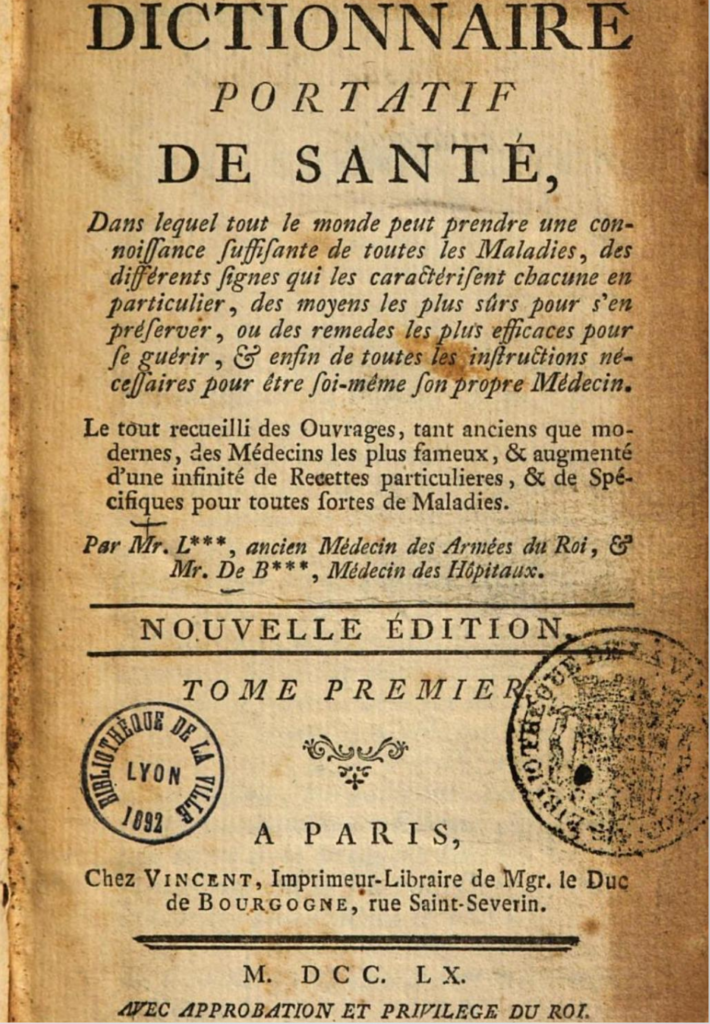Dictionnaire portatif
| Title | Dictionnaire portatif de santé dans lequel tout le monde peut prendre une connaissance suffisante de toutes les maladies, des différents signes qui les caractérisent, des moyens les plus sûrs pour s’en préserver ou des remèdes les plus efficaces pour se guérir, et enfin de toutes les instructions nécessaires pour être soi-même son propre médecin |
|---|---|
| Contributor(s) |
Vandermonde, Charles-Augustin
(author) |
| Year | 1760 |

This is a visualisation taken from Voyant Tools which shows the most common words and concerns of this text and how it pertains to the female body.
Emerging in the 18th century is the appearance of the “dictionnaire portatif”, home-use manuals intended for use by those suffering from illness or their families while waiting for doctors to arrive. The work of Charles-Augustin Vandermonde (1727-1762) and his 1760 edition of Dictionnaire portatif de santé dans lequel tout le monde peut prendre une connaissance suffisante de toutes les maladies, des différents signes qui les caractérisent, des moyens les plus sûrs pour s’en préserver ou des remèdes les plus efficaces pour se guérir, et enfin de toutes les instructions nécessaires pour être soi-même son propre médecin, is our focus here. Vandermonde’s own medical background involved a stint at the Paris Faculté de Médecine.

This text is divided into three volumes. Opening with a list of common medicines followed by Latin names for illnesses, the text is structured into alphabetical sections detailing potential causes for concern of the body. While this work is intended for a general audience and not specifically for those working with female bodies, we have included it here as it plays a role in democratising access to this type of specialised knowledge that had previously been in the domain of highly educated medical practitioners. There are many surviving copies, suggesting each edition had a wide reach and was valued as a medical book in French society. One interesting aspect of this text is that it was printed under the pseudonym of “Mr L***” (Vandermonde, 1760, p. v), an element noted in other medical texts of this time.
However, Vandermonde is also a controversial figure in medical literature today, as he wrote extensively on eugenics and propagated ideas on human population control in order to attain the perfect human specimen. Asserting (male) control over the reproductive system is a feature of medical literature of the Enlightenment, as advancement in scientific knowledge and societal norms about the place of women were joined with more precise ways of reading and interpreting the female body. The female body is conceptualised abstractedly by Vandermonde; he seldom addresses women directly, referring to their ailments and addressing their remedies by using the imperative. He is distant from the subject and there is a scant use of the personal pronoun, compared to its abundance in English language texts.
Despite this, the text is a useful addition to our corpus, despite the fact that its genre and style of writing demarcates from the other, more homogenous texts we study, especially those from the 17th century that share common features and a common historical context, both temporal and geographical. These texts also bear hallmarks of having been copied and distributed in similar settings. Dictionnaire thus offers an insight into the French medical environment in the decades before the turmoil of the Revolution.
Consult the source
Source
We consulted two editions of this text, the first published in 1760 hosted by Google Books and the second published in 1777, housed by Gallica. We seldom cite from the later version and the 1760 file served as our .txt file for our data manipulations.



